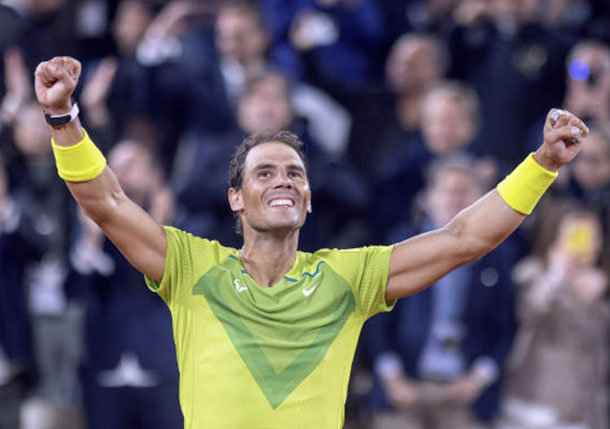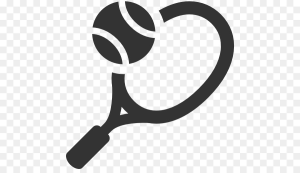Five Things We Learned From New Book on Rafa Nadal and Roland-Garros

05/14/2025 10:04 AM
A new book explore the unique connections and historuy between Rafael Nadal, clay, and Roland-Garros.
By Erik Gudris | @atntennis | Wednesday May 14, 2025
Rafael Nadal and his dominance on clay, especially at Roland-Garros, are explored in-depth in the new book, The Warrior: Rafael Nadal and His Kingdom of Clay.
Acclaimed tennis journalist Christopher Clarey, formerly of the New York Times and the International Herald-Tribune, explores Nadal's legendary career by focusing primarily not only on why he excelled particularly on clay, but also on the history of the surface and its most famous tournament, which Nadal won an incredible 14 times.
Here are five things we learned after finishing this must-read book.
Big moment for me. The Warrior publishes today in the USA and Canada. 22 years in the making. 2 years in the writing. I went deep on Rafael #Nadal's code & career & on #RolandGarros, the dusty Parisian showplace with which he will always be associated.
— Christopher Clarey 🇺🇸 🇫🇷 🇪🇸 (@christophclarey) May 13, 2025
Vamos! pic.twitter.com/TFavbLNnAI
The French Championships Were First Played on Grass
Before the event became known as Roland-Garros (named for the famed WWI aviator), the "French Championships" were contested at various tennis clubs before the inaugural edition was held at the Racing Club on Paris's western outskirts in 1891. Although not officially proven, the first matches were played on grass. So why the switch to clay, which likely happened before 1900? Tennis historians believe it was due to clay being easier to maintain than grass and clay courts becoming more common in southern Europe because of climate and resources.
Early Bad Luck for Nadal Opened the Door for Gaston Gaudio
At age 16, a young Nadal burst onto the scene and made an impression at the lead-up clay court events in 2004 before Paris, including earning wins over then reigning Roland-Garros champion Albert Costa and then later over another former champion Carlos Moya. Expectations were high that Nadal could make a sizable run in Paris.
But before he left Mallorca for Paris, Nadal hit some tennis with friends and jumped the net for fun. But some of his friends, thinking it would be funny, lifted the net as he did. Nadal fell and suffered a slight fracture in his right elbow. As a result, he missed competing at Paris that year. His absence, perhaps, opened the door for eventual and surprise champion Gaston Gaudio of Argentina to win the title in five sets over his countryman Guillermo Coria.
Nadal would go on to win his first Roland-Garros title in 2005 over Mariano Puerta.
Rafael Nadal and Roland-Garros, a love story since 2005 🧡 pic.twitter.com/mRKQXQlTZI
— Roland-Garros (@rolandgarros) April 18, 2025
Nadal Admits His On-Court Rituals Are a "Disaster"
Much was said and written about Nadal's on-court "rituals" or "tics" during his career, from organizing his water bottles in front of his chair a certain way, to adjusting his hair, shirt and shorts before each serve, just to name a few. In fact, as he grew older, the routine became even more elaborate.
Yet, despite the belief by many that Nadal has OCD, that has been denied by both him and his team. However, Nadal when asked about the rituals admitted they are strictly for the court only.
"They're a disaster, sincerely," he said. "People see my routines on the court and believe that I am someone with lots of routines and superstitions outside the court, but outside the court I am practically at zero. I need to be really organized when I am competing, but in my personal life, I'm someone who is really disorganized and someone who is not really on time or super type A. But when I am on the court, the routines allow me to stay totally concentrated on what there is to do."
Nadal and Federer Camps Weren't Always So Friendly
Despite their long rivalry, both Nadal and Roger Federer now share a good friendship and admiration for each other. But, that wasn't the case early on in their careers, especially between their respective teams when Nadal began to threaten the World No. 1 Federer, who still dominated the ATP Tour.
By 2006, Nadal and Federer's team were known to speak ill of the other player in private. Nadal's camp thought Federer wasn't disciplined with his diet and not having the same work ethic as Nadal.2004: The first time Roger Federer and Rafael Nadal shared the court. They were doubles opponents. They wore matching outfits.
— Bastien Fachan (@BastienFachan) March 28, 2025
2022: The last time Roger Federer and Rafael Nadal shared the court. They were doubles partners. They wore matching outfits.
Happy 21 years of Fedal ❤️ pic.twitter.com/BysDGSQ1PB
On Federer's side, some in his team wondered how Nadal could demonstrate his ferocious staying power on court and asked officials how often Nadal was being drug tested.
The back-and-forth sniping got so bad that eventually the ATP stepped in and asked both sides to communicate with each other directly and not rely on false rumors.
As Nadal's agent Benito Perez-Barbiadillo remembers of the time, "They (Nadal and Federer) were truly two good human beings, so they had to talk to each other and not hear what the entourages were saying."
Will the Stadium Court in Paris Be Named for Nadal Someday?
Throughout Nadal's career, and his dominance over Roland-Garros, it's no surprise that the French fans, because Nadal is Spanish, went from suspicion to begrudging acceptance, to finally overt acclaim for Nadal's achievements at the event. However, the rumors that one day the main stadium court will be renamed in Nadal's honor are just that.
Currently, the court is named in honor of the late International Tennis Federation president Philippe Chatrier. If the court is ever renamed, it's possible it will be for a French player down the road.VIDEO: Days before the French Open kicks off, a statue of Rafael Nadal is unveiled at Roland Garros pic.twitter.com/9YEIytjCtR
— AFP News Agency (@AFP) May 29, 2021
Yet just outside the complex's front gate is a new ten-foot stainless steel statue of an airborne Nadal that celebrates his immortal status as the "King of Clay."
The Warrior: Rafael Nadal and His Kingdom of Clay is now available in stores and online.


